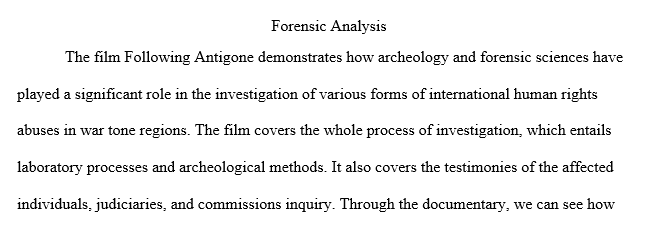Forensic Analysis
Forensic Anthropology and Human Rights Investigations
Visit the Archaeology Channel at http://archaeologychannel.org/video-guide/video-guide-menu/video-guide-list/241-following-antigone-forensic-anthropology-and-human-rights-investigations (Links to an external site.) and watch the video titled Following Antigone (email me if the link doesn’t work – sometimes you can locate the video on youtube too). This film tells how forensic sciences and archaeology have been used to investigate international human-rights abuses in troubled spots around the world. The Argentine Forensic Anthropology Team (EAAF), an international Non-governmental Organization (NGO), took footage of forensic investigations they carried out in Argentina, El Salvador, Ethiopia, Haiti, and East Timor in order to tell the story of what they do. Exhumation and reburial sequences document the heavy emotional toll befalling survivors and their families.
The documentary covers the entire process of investigation, including historical, archaeological, and laboratory methods, testimonies of relatives of the victims, and reburial ceremonies of the remains of their loved ones many years after they died. It touches upon relationships with families of victims, local judiciaries, human rights organizations, and special commissions of inquiry. It also describes the ways in which forensic evidence can be used in trials, issues of reburial, and the rectification of historical records. This is the reality of forensic anthropology, one of the most difficult and challenging aspects of the field.
Write a 1-2 page reflection about how the efforts of forensic anthropologists shown in this film have helped families to recover identities and find closure.
Hello, simple paragraph and simple words are fine. Thank you.
613 Words
APA
